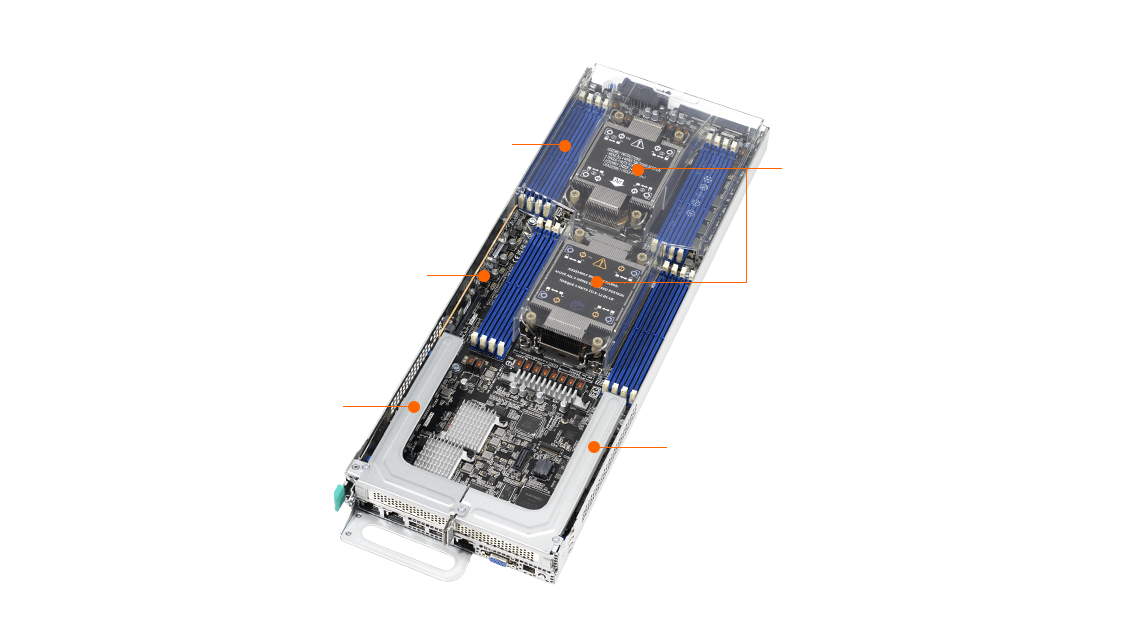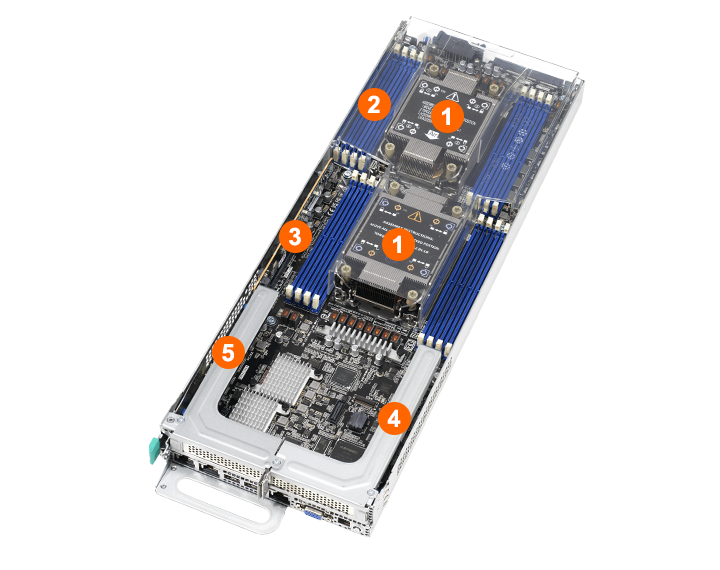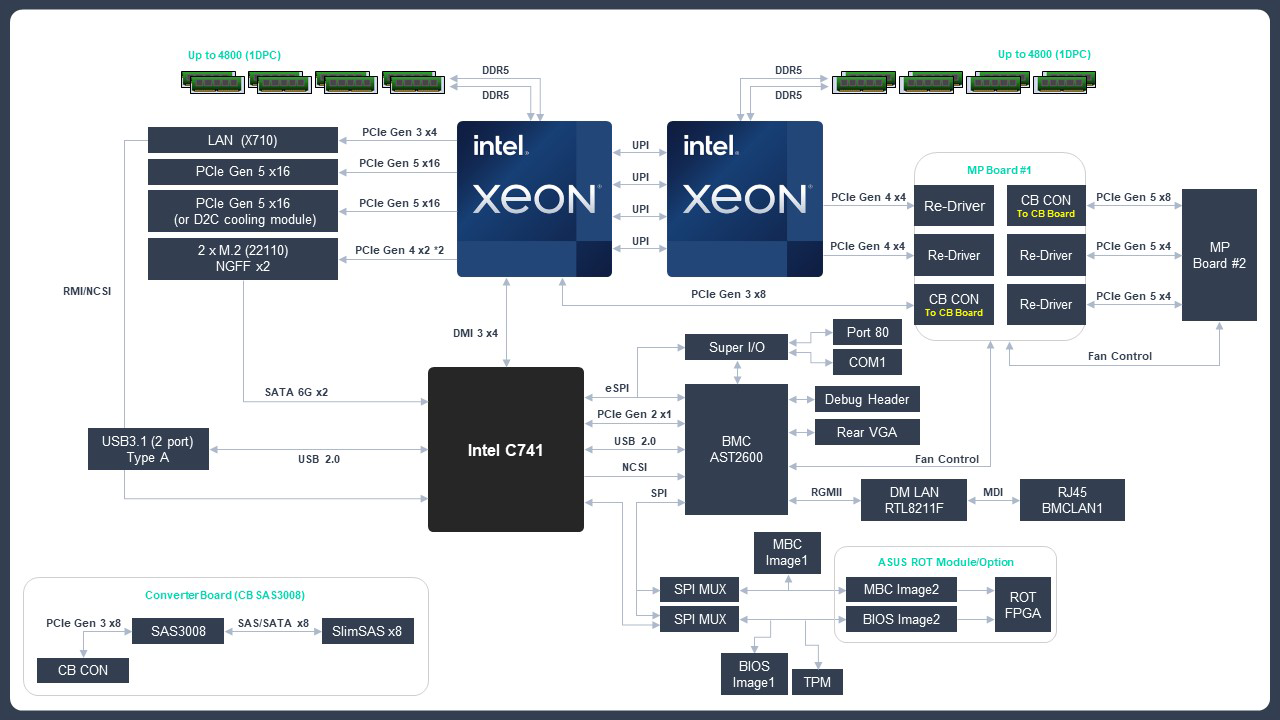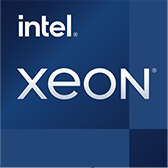High CPU
Performance
2 sockets
PCI Express® (PCIe®) 5.0 delivers 32GT/s bandwidth, which is twice the speed of PCIe 4.0, and offers lower power consumption, better land scalability and backwards compatibility. ASUS servers are PCIe 5.0 ready with scalability design to satisfy the increasing workloads for modern data center.


12 x 5th Gen Intel® Xeon®
Scalable Processors
(Air cool with EVAC up to 270W, with STD HSK up to 205W)
216 x DDR5 DIMM slots
(8CH DDR5, up to
5600MHz, RDIMM)
32 x M.2
41 x PCIe x16 (Gen5 x16 link),
LP (HHHL)
51 x PCIe x16 (Gen5 x16 link),
LP (HHHL)
* SAS support only from optional CB board.


1Front Panel Node 4
2Front Panel Node 3
38 x 2.5" Hot-swap Storage Bays
(8 x NVMe supported)*
4Node 1
(Bay1-2)
5Node 2
(Bay3-4)
6Node 3
(Bay5-6)
7Node 4
(Bay7-8)
8Asset Tag
9Front Panel Node 2
10Front Panel Node 1
* Optional 3008 SAS Controller is required to support SATA/SAS hard drives


11 x PCIe x16 (Gen5 x16 link), LP (HHHL)
21 x Port 80
31 x VGA port
41 x Management LAN port
51 x PCIe x16 (Gen5 x16 link), LP (HHHL)
62 x USB 3.1 ports
72 x Intel X710-AT2
8Optional
1+1 Redundant 3000W 80
PLUS Titanium CRPS

Transform your data center TCO with the high-density server powered by 5th Gen Intel® Xeon® Scalable Processors. With an innovative design that fits four nodes in a 2U chassis, RS720Q-E11-RS8U accommodates dual-socket CPUs, PCIe 5.0 to satisfy the increasing demands for efficiency, density and TCO-optimization for data centers, web servers, virtualization, cloud and hyperscale environments.
2 sockets
2 slots
16 DIMM
8 bays
10 Gigabit
5th Gen Intel® Xeon® processors unleashes up to 21% average general-purpose performance gain, significantly improving AI inference and training, all via the drop-in-compatible LGA-4677 socket. This innovation powerhouse accelerate AI, HPC, Analytics, Networking, Storage and offer eight DDR5-5600 memory channels for up to 2 TB capacity, 80 PCI Express® 5.0 lanes with CXL 1.1 support, and a 350 W TDP for 1P and 2P configurations — ready for the future of computing.

The new AMD EPYC 9004 processors excel at providing full features and functionality for both dual-socket and single-socket platforms, but our new servers ASUS is introducing an CPU-balanced architecture to enable secure and optimal CPU-performance efficiency.
This architecture extends the full bandwidth to either dual- or single-CPU configurations, enabling more computing capability and much-improved overall power efficiency for compute-intensive workloads. This architecture allows customers to take full advantage of bandwidth capabilities of the dual-CPU architecture with a single CPU, while offering the flexibility to upgrade later with the addition of a second CPU.
* Features, specification and design vary by models and configuration.
ASUS holds the most amount of records in dual-socket (2P) and single-socket (1P) on SPEC CPU 2017 benchmark and dominate the computing performance. These top performance results provide a useful insight into compute-intensive workloads on different computer systems, enabling our customers to reduce complexity, tackle challenging workloads and accelerate system validations.
ASUS servers feature Performance Boost technology to achieve the best server performance and agility by tuning servers to match the requirements of workloads, letting you gain greater control of your server environment. This technology improves workload throughput by maximizing processor frequency and boost power, ideal for timesensitive applications such as financial services or data center operations.

Maximizes the processor frequency in multi-core operations, avoiding frequency shifting for reduced latency.

Automatic power acceleration with an innovative voltage design to increase server overall performance.

Preconfigured BIOS server profiles based on workloads and benchmarks for improved performance and efficiency.
* SPEC is a corporation formed to establish and endorse standardized benchmarks and tools to evaluate performance and energy efficiency of computer systems.
ASUS select servers achieved most power efficiency positions on the SPEC Power benchmark for energy efficiency and demonstrate to customers how they can achieve faster deployments and higher energy efficiency for their IT infrastructure.

Adjust overall loading automatically based on real-time monitoring to decrease overall power consumption for Improved efficiency and cost/performance optimization.

Features intelligent fan-curve adjustments to fit the real-time server usage patterns and lower fan power consumption.
ASUS ASMB11-iKVM is the latest server-management solution from ASUS, built upon the ASPEED 2600 chipset running on the latest AMI MegaRAC SP-X. The module provides various interfaces to enable out-of-band server management through WebGUI, Intelligent Platform Management Interface (IPMI) and Redfish® API.

ASUS Control Center (ACC) is remote IT management software designed for monitoring your hardware and software IT assets and inventory status and enabling seamless remote BIOS configurations and updates, efficient IT diagnostics and troubleshooting and enhanced security with Hotfix updates, allowing easier server management for any IT infrastructure.

ASUS servers integrate PFR FPGA as the platform Root-of-Trust solution for firmware resiliency to prevent from hackers from gaining access to infrastructure. ASUS security solutions are fully compliant with the 2018 National Institute of Standards and Technology (NIST) SP 800 193 specification.
* Platform Firmware Resilience (PFR) module must be specified at time of purchase and is factory-fitted. It is not for sale separately.
ASUS servers also include support Trusted Platform Module 2.0 (TPM 2.0) to secure hardware through integrated cryptographic keys and offer regular firmware update for vulnerabilities.